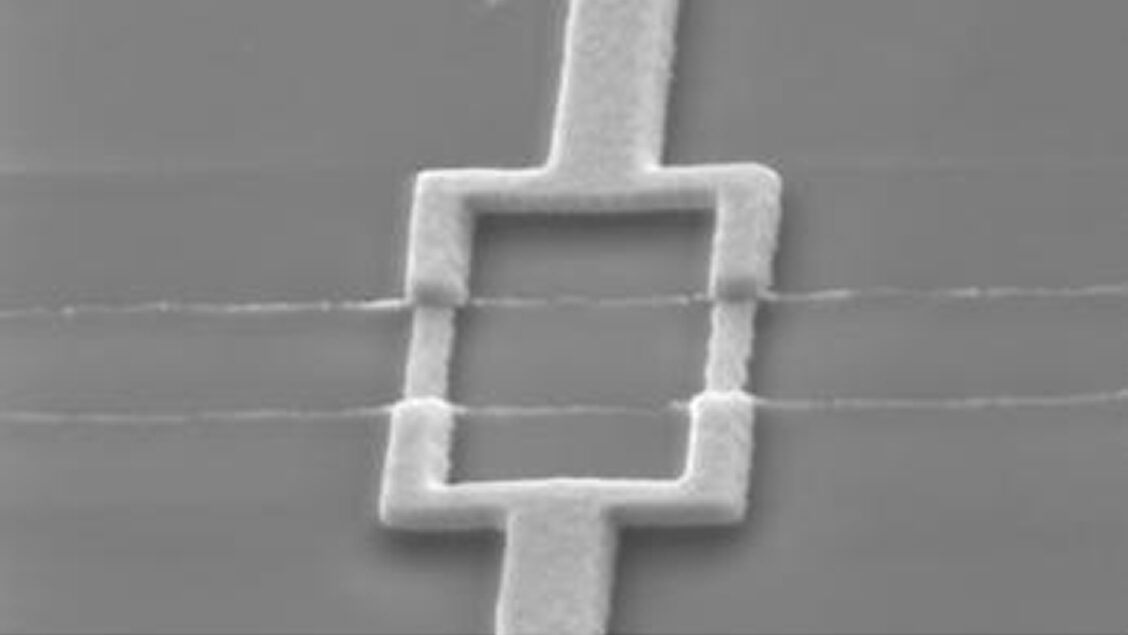The electronic properties of mesoscopic samples are modified by electronic interference if their size is smaller than the phase coherence length. Our team probes systems for which the quantum effects are particularly important such as topological insulator, grahene or carbon nanotube. We list below some of our latest results.
Paramagnetic Singularities of the Orbital Magnetism in Graphene with a Moiré Potential
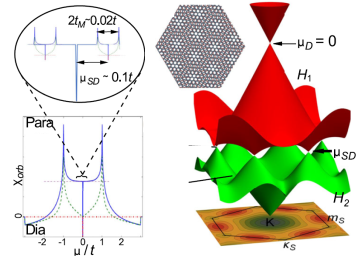
The recent detection of the singular diamagnetism of Dirac electrons in a single graphene layer paved a new way of probing 2D quantum materials through the measurement of equilibrium orbital currents which cannot be accessed in usual transport experiments. Among the theoretical predictions is an intriguing orbital paramagnetism at saddle points of the dispersion relation. Here we present magnetization measurements in graphene monolayers aligned on hexagonal boron nitride crystals. Besides the sharp diamagnetic McClure response at the Dirac point, we detect extra diamagnetic singularities at the satellite Dirac points of the moiré lattice. Surrounding these diamagnetic satellite peaks, we also observe paramagnetic peaks located at the chemical potential of the saddle points of the graphene moiré band structure and relate them to the presence of van Hove logarithmic singularities in the density of states. These findings reveal the long ago predicted anomalous paramagnetic orbital response in 2D systems when the Fermi energy is tuned to the vicinity of saddle points.
Reference : J. Vallejo Bustamante et al., Phys. Rev. Lett. 131, 116201 (2023).
Long-lived Andreev states as evidence for protected hinge modes in a bismuth nanoring Josephson junction

Second-order topological insulators are characterized by helical, non-spin-degenerate one-dimensional states running along opposite crystal hinges with no backscattering. Injecting superconducting pairs therefore entails splitting Cooper pairs into two families of helical Andreev states of opposite helicity, one at each hinge. Here we provide evidence for such separation via the measurement and analysis of the switching supercurrent statistics of a crystalline nanoring of bismuth. Using a phenomenological model of two helical Andreev hinge modes, we find that pairs relax at a rate comparable to individual quasiparticles, in contrast to the much faster pair relaxation of non-topological systems. This constitutes a unique telltale sign of the spatial separation of topological helical hinges.
Reference : A. Bernard et al., Nat. Phys. 1 (2023).
Detection of graphene’s divergent orbital diamagnetism at the Dirac point

The electronic properties of graphene have been intensively investigated over the past decade. However, the singular orbital magnetism of undoped graphene, a fundamental signature of the characteristic Berry phase of graphene’s electronic wave functions, has been challenging to measure in a single flake.
Using a highly sensitive giant magnetoresistance (GMR) sensor, we have measured the gate voltage–dependent magnetization of a single graphene monolayer encapsulated between boron nitride crystals. The signal exhibits a diamagnetic peak at the Dirac point whose magnetic field and temperature
dependences agree with long-standing theoretical predictions. Our measurements offer a means to monitor Berry phase singularities and explore correlated states generated by the combined effects of Coulomb interactions, strain, or moiré potentials.
Reference : Vallejo Bustamante et al., Science 374, 1399–1402 (2021) (direct link).
Microwave photoassisted dissipation and supercurrent of a graphene-superconductor ring
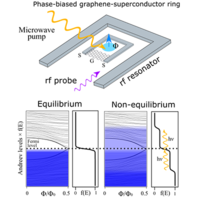
Irradiating normal-superconducting junctions with microwave photons produce spectacular effects, such as Shapiro steps and photoinduced modifications of the dc supercurrent. Moreover, microwave irradiation can also have other, hitherto unexplored consequences, such as a photoassisted dissipation which is phase dependent.
Here we present a finite-frequency measurement of both the dissipation and the supercurrent of a phase-biased graphene-superconductor junction in response to microwave photons. We find that, while the supercurrent response is well described by existing theory, the dissipation exhibits unexpected effects which need new theoretical elucidation. Especially with high frequency photons, the dissipation is enhanced at phase zero, where it is minimum without irradiation.
We attribute this enhancement to Andreev level transitions, made possible by microwave-induced nonequilibrium population of Andreev bound states. Our results demonstrate that dissipation is a more sensitive probe of microwave photons than is the supercurrent, and reveal the potential of measuring dissipation to improve superconducting photodetectors and investigate photoassisted physics in hybrid superconducting systems.
Reference : Z. Dou et al, Phys. Rev. Research 3, L032009 (2021)
Collapse of the Josephson Emission in a Carbon Nanotube Junction
We have measured a surprising collapse of the high frequency emission of a superconducting junction made with a carbon nanotube.

We probe the high frequency emission of a carbon nanotube based Josephson junction and compare it to its dc Josephson current. The ac emission is probed by coupling the carbon nanotube to an on-chip detector (a superconductor-insulator-superconductor junction), via a coplanar waveguide resonator. The measurement of the photoassisted current of the detector gives direct access to the signal emitted by the carbon nanotube. We focus on the gate regions that exhibit Kondo features in the normal state and demonstrate that when the dc supercurrent is enhanced by the Kondo effect, the ac Josephson effect is strongly reduced. This result is compared to numerical renormalization group theory and is attributed to a transition between the singlet ground state and the doublet excited state which is enabled only when the junction is driven out-of-equilibrium by a voltage bias.
Reference : D. Watfa et al., Phys. Rev. Lett. 126, 126801 (2021)
Topological protection demonstrated via microwave measurements
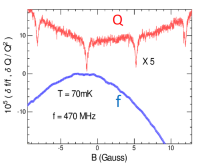
Demonstrating the topological protection of Andreev states in Josephson junctions is an experimental challenge. It was predicted that low temperature ac susceptibility measurements could reveal the topological protection of quantum spin Hall edge states by probing their phase-dependent, low-energy Andreev spectrum at finite frequency. Topological protection leads to a perfect Andreev level crossing at a phase difference of pi, which translates in a peaked dissipative response at pi.
We have performed such a microwave probing of a phase-biased Josephson junction built around a bismuth nanowire, a predicted second order topological insulator, in which we previously detected one-dimensional ballistic edge states. We find absorption peaks at the Andreev level crossings, whose temperature and frequency dependencies point to protected topological crossings with an accuracy limited by the electronic temperature of our experiment.
Reference : A. Murani et al, Phys. Rev. Lett. 122, 076802 (2019)
High kinetic inductance superconducting nanowires
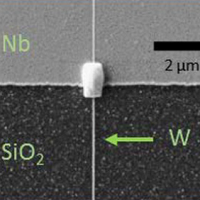
Joint efforts involving two teams from the LPS have demonstrated that beam-assisted deposition of superconducting materials with a He-based focused ion beam (He-FIB) can be used to design and deposit superconducting nano-objects with a versatile direct write process. In particular, nanowires could be made very thin (5nm), narrow (35nm) and long (400µm), demonstrating a very high kinetic inductance, 250 times larger than the geometrical one.
This technological breakthrough was made possible by the unique properties and stability of a recently acquired helium focused ion beam machine. These nanowires hold a great promise for superconducting circuits applications.
Reference : J. Basset et al., Appl. Phys. Lett. 114, 102601 (2019)
Revealing ballistic transport in topological bismuth nanowires
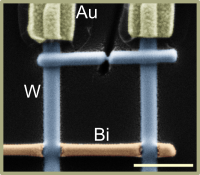
The current through two-dimensional topological insulators is predicted to run only through a few, perfectly conducting, narrow channels. We have used superconducting electrodes to reveal the ballistic nature of the current through bismuth nanowires, suggesting they are good topological insulator candidates.
We have exploited this sensitivity of the current phase relation to probe conduction through topological insulators. The current through such materials is predicted to run only through a few perfectly ballistic channels, called topological edge states. The topological insulator candidate is a monocrystalline bismuth nanowire whose crystalline orientation is chosen such that it contains two topological surfaces, each with one-dimensional edge states. And indeed, we have found that the supercurrent through a 1.4 micrometer-long monocrystalline bismuth nanowire has just such a sawtooth-shaped dependence on the phase difference between the superconductors at its ends. The fact that transport is ballistic over such a long distance hints to a possible topological protection against scattering in those wires.
References :
Frank Schindler et al, Nature Physics 14, 918–924 (2018)
Anil Murani et al, Nature Communications 8, 15941 (2017)
Electronic interactions make noise !

Although electronic interactions are generally negligible in metals, confinement of electrons in a quantum dot, such as a carbon nanotube, enhances them. A striking consequence of electronic interactions in a metal is the Kondo effect, where the spin of magnetic impurities is screened by conduction electrons at low enough temperature. This same effect emerges for a quantum dot coupled to metallic electrodes: the spin of the quantum dot is screened by the conduction electrons of the electrodes resulting in a singlet state of spin zero.
Thanks to a collaboration between the LPS and Osaka University (Japan), it was possible to measure the shot noise, i.e. the fluctuations in the backscattered current due to the variations in the number of charges reflected by the quantum dot. Our experiment was realized in a carbon nanotube connected to metallic electrodes. Two signatures of the Kondo state emerged. First, at low current the delocalized state transmits perfectly the current through the dot, without any backscattering. The quantum dot is thus totally silent. At high current, noise increases rapidly and non-linearly. The non-linear shot noise measures the effective charge of the backscattered carriers. Our measurement of the effective charge, e*=5/3 ± 5%, is in perfect agreement with theory, and demonstrates the appearance of electrons pairs. Moreover we have shown that this value is universal for any spin ½ Kondo system.
References :
Meydi Ferrier et al, Phys. Rev. Lett. 118, 196803 (2017)
Meydi Ferrier et al, Nature Physics 12, 230–235 (2016)
How to control the magnetic state of a quantum dot with the superconducting phase?
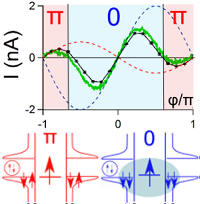
We have demonstrated the control by the superconducting phase of the magnetic state of a quantum dot connected to two superconducting reservoirs. It happens in the regime of strongest competition between the Kondo effect (screening of the dot spin by the conduction electrons of the reservoirs) and the superconducting proximity effect. This has spectacular consequences on the relation between the supercurrent and the superconducting phase: the current phase relation. Indeed the junction behaves both as a regular junction (“0” junction) and junction with opposite sign (“pi” junction). To create this experiment, a carbon nanotube, which acts as a quantum dot, is inserted in a SQUID and measured at very low temperature. The current-phase relation is extracted from the supercurrent of the SQUID which is modulated by the phase difference controlled by a magnetic field. A successful comparison with theoretical prediction was carried out. This experiment demonstrates the control of the magnetic state of a quantum dot by the superconducting phase and paves the way to current phase relation measurements in strongly correlated mesoscopic systems.
References :
R. Delagrange et al., Phys. Rev. B 93, 195437 (2016)
R. Delagrange et al. Phys. Rev. B 91, 241401(R) (2015)
